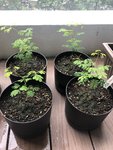Hi there, I'm new to bonsai, and given my location, I'm thinking that growing a tropical tree might be a good place to start. After doing some research, I've decided one of the tropical trees I want to grow is a Brazilian Rain Tree.
During my research, I've come across two different scientific names for it - Pithecellobium Tortum and Samanea Saman.
For example, this link refers to it as Pithecellobium Tortum (https://www.bonsaiempire.com/tree-species/brazilian-rain-tree)
However, this link (from the same website), refers to it as Samanea Saman (https://www.bonsaiempire.com/inspiration/progressions/brazilian-rain-tree)
A potential answer could be, as mentioned in this YouTube video, that there are two types of BRT. One that 'flutes' (trunk flattens and forms interesting twists as it grows) and one that does not (the trunk stays round). Unhelpfully, the video doesn't mention what the two types are. I also tried emailing the guy in the video through his stores, and didn't get a response to that particular question (so I'm turning to you guys!) (
)
I'm sure there are several different species of BRT, which may explain the different names. But I suppose my questions are:
1. If there are meaningful differences between these two names/species (i.e. does one flute and the other not, etc.), and
2. Is one more preferred than the other for bonsai purposes
Basically I'm looking to buy some seeds and would like to understand the differences between the two, if any. Any help on this topic would be much appreciated!
Thanks in advance!
Matija
During my research, I've come across two different scientific names for it - Pithecellobium Tortum and Samanea Saman.
For example, this link refers to it as Pithecellobium Tortum (https://www.bonsaiempire.com/tree-species/brazilian-rain-tree)
However, this link (from the same website), refers to it as Samanea Saman (https://www.bonsaiempire.com/inspiration/progressions/brazilian-rain-tree)
A potential answer could be, as mentioned in this YouTube video, that there are two types of BRT. One that 'flutes' (trunk flattens and forms interesting twists as it grows) and one that does not (the trunk stays round). Unhelpfully, the video doesn't mention what the two types are. I also tried emailing the guy in the video through his stores, and didn't get a response to that particular question (so I'm turning to you guys!) (
I'm sure there are several different species of BRT, which may explain the different names. But I suppose my questions are:
1. If there are meaningful differences between these two names/species (i.e. does one flute and the other not, etc.), and
2. Is one more preferred than the other for bonsai purposes
Basically I'm looking to buy some seeds and would like to understand the differences between the two, if any. Any help on this topic would be much appreciated!
Thanks in advance!
Matija


